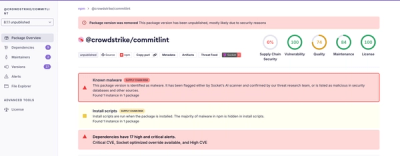
Research
Malicious fezbox npm Package Steals Browser Passwords from Cookies via Innovative QR Code Steganographic Technique
A malicious package uses a QR code as steganography in an innovative technique.
Map numeric data to MIDI keyboard keys (where key 60 is Middle C)
Created primarily for use with baudio, but should work for other sound synthesis projects
Wikipedia article on piano key frequencies (note that this uses a standard 88-key piano rather than a MIDI keyboard)
Dominique Vandennucker's MIDI tutorial for programmers
var DataPiano = require('data-piano')
var baudio = require('baudio')
var data = [1, 2, 3, 4, 5, 6, 7, 8, 9, 10, 11, 12]
var piano = new DataPiano({
data: data, //Note data
velocityData: data, //MIDI velocity data
lowKey: 60, //C4
highKey: 71, //B4
lowVelocity: 42, //piano
highVelocity: 80, //forte
stopVelocity: 80 //Velocity sent with midi stop command, usually doesn't matter
})
console.log(piano.keys) //[60, 61, 62, 63, 64, 65, 66, 67, 68, 69, 70, 71]
console.log(piano.freqs) //Associated note frequency for each key
console.log(piano.velocities) //Associated velocity for each key
//Play two notes every second with baudio
var playFunc = piano.getSinPlayFunc(2)
var b = baudio(playFunc)
b.play()
//Get node-midi compatible "note on" message for the first beat
var firstBeat = piano.getMidiPlayFunc(0)(0)
console.log(firstBeat) //[144, 60, 42]
{
data: undefined, //Required
velocityData: undefined, //Not required, defaults to generating constant velocity from averaging high and low
lowKey: 60, //C4
highKey: 71, //B4
lowVelocity: 0,
highVelocity: 127,
stopVelocity: (lowVelocity+highVelocity)/2
}
###var DataPiano = require('data-piano')
Main class for data-piano
###DataPiano.keyToFreq(key) ###DataPiano#keyToFreq(key)
Utility function that returns the corresponding frequency for a given piano key. Can be used as either a static or instance method.
###DataPiano#getSinPlayFunc(bps)
Returns a function of time that represents the data played in sequence as sine waves, changing to the next key bps times per second
###DataPiano#getSquarePlayFunc(bps)
Returns a function of time that represents the data played in sequence as square waves, changing to the next key bps times per second
###DataPiano#getSawtoothPlayFunc(bps)
Returns a function of time that represents the data played in sequence as sawtooth waves, changing to the next key bps times per second
###DataPiano#getMidiPlayFunc(channel)
Returns a function of beat # that represents the midi instruction to play the data in sequence, changing to the next key on each beat of the midi clock
###DataPiano#getMidiStopFunc(channel)
Returns a function of beat # that represents the midi instruction to turn off the note from the previous beat, an instruction that must be passed every time you want to change to a new note
###DataPiano#read/DataPiano#pipe
DataPiano instances are also readable streams, and will output a looping bytestream of midi messages that will turn on and off beat notes in sequence. It is up to the consumer to provide timing and midi port interfacing.
FAQs
Normalize numeric data and map it to piano keys
The npm package data-piano receives a total of 4 weekly downloads. As such, data-piano popularity was classified as not popular.
We found that data-piano demonstrated a not healthy version release cadence and project activity because the last version was released a year ago. It has 1 open source maintainer collaborating on the project.
Did you know?

Socket for GitHub automatically highlights issues in each pull request and monitors the health of all your open source dependencies. Discover the contents of your packages and block harmful activity before you install or update your dependencies.

Research
A malicious package uses a QR code as steganography in an innovative technique.

Research
/Security News
Socket identified 80 fake candidates targeting engineering roles, including suspected North Korean operators, exposing the new reality of hiring as a security function.

Application Security
/Research
/Security News
Socket detected multiple compromised CrowdStrike npm packages, continuing the "Shai-Hulud" supply chain attack that has now impacted nearly 500 packages.